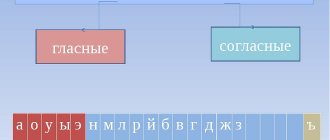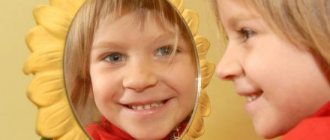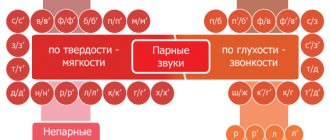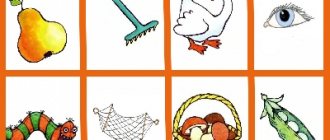Articulation gymnastics
1. Lower jaw. Open your mouth quite wide and begin chewing movements. Repeat the exercise for 15 seconds.
2. Lips and cheeks.
- close your lips and take air into your mouth. Start by rinsing your mouth, as if brushing your teeth;
- imitate a horse snorting;
- pouting of lips (upper, lower).
3. Language.
- exercise “Mushroom”: wide smile, mouth open. The tongue, in a flat state, is sucked to the palate behind the upper incisors. Hold in this position for 10-15 seconds;
- exercise "Horse". The clicking of the tongue against the roof of the mouth, as if we were making the sound of horse hooves on a stone path;
- exercise "Swing". The mouth is open (wide), teeth are exposed. In turn, the tongue goes behind the lower and then upper teeth. Repeat 5-6 times.
4. Soft palate. Play vowel sounds of the adult's choice.
Diagnosis of pronunciation D
Due to the immaturity of the articulatory apparatus in childhood, the sound D may be confused with other sounds: , or even .
The following defects are encountered when pronouncing D:
- Deafening: D - T. The reason for deafening is that articulation with D is similar to the sound T, and as a result of insufficient formation of phonemic perception or defective development of the speech apparatus as a whole, the sound is replaced by a voiceless paired T. The defect is eliminated with the help of the phoneme B. In this In this case, it is necessary to start producing the sound from the word BA. We say BA-BA quickly, without pausing. We lift the tongue up, it continues to work BA-DA, BA-DA. Now D becomes more sonorous, and in the end we get YES-YES-YES.
- The open nasality of D-N. The velum is slightly lowered, the tip of the tongue is passive, there are no jerky air flows from the mouth, only a continuous stream of air from the nasal cavity. It is necessary to eliminate the transmission of the air stream through the nose, and direct the air through the mouth. The air stream should come explosively, in jerks.
- Clicking D. Work in the same ways as with defects 1 and 2, achieving the movement of the air stream in jerks through the oral cavity.
To identify deficiencies in the sound pronunciation of D, a small diagnostic test should be performed.
- When pronouncing sentences where D occurs quite often, ask the child to repeat what he heard. You can take the following phrase: Dasha gave Dana a pipe.
- Show your child several pictures depicting objects or living objects whose names begin with D or D. Then the child says what is shown in the illustrations. You can take pictures with drawn: children, house, woodpecker, board, etc.
- Pictures are laid out on the table. The adult asks to find, show and name any of them. All drawings depict objects with names starting from D-D.
History of the letter D
The Church Slavonic name for this letter is “good”.
The appearance of the letter D is borrowed from a Greek letter called delta, which looks like a triangle. Only the printed Greek version has no legs.
But in the letter the paws are drawn.
Some people wonder why the printed letter D has two legs, but only one tail is written down on the letter.
This happened somewhere in the 14th-17th centuries. Then the formation of cursive writing began in the Russian language. And the letters of the alphabet began to lose some of their graceful elements.
This happened with lowercase D. It became slightly rounded, its curls fell off, and instead a tail-loop grew from below.
It is interesting that in the manuscripts of that time, when the formation of the written letter D was just being improved, two tails were observed at once: above and below. But drawing such a miracle was not in the rules of cursive writing, so they decided to cut off the upper tail once and for all.
So the letter acquired the form to which we are accustomed now.
And in the 18th century, Peter the Great, the letter D with one tail at the bottom was officially approved. The reason for this decision was that the two lower legs of the letter D seemed to remain, they were simply connected into a loop.
The option with an upper ponytail also remained in use. They began to choose: either the lower ponytail or the upper one.
It was the writing of the letter D with an upper loop tail that was popular among highly educated people. Leo Tolstoy wrote the letter D with an upper loop.
Ordinary people quickly switched to D with a lower loop.
The letter B occupies the second place of honor in the Russian alphabet. In the Glagolitic alphabet it corresponds to the numerical value 2.
In the Church and Old Church Slavonic alphabet it is called “buki” or “buki”, which translated means “letter”.
The letter D is the fifth from the beginning, twenty-ninth from the end of the alphabet and refers to paired voiced consonants. Its pair sound [T] is a voiceless consonant.
At the beginning of a word and in the middle, the letter D sounds loud, and at the end of the word it is deafened, so that its paired sound T is already heard.
Example: tree - bucket - vegetable garden. In the last word we hear T instead of D.
In the Church and Old Slavonic alphabet it is called “Good”.
She came to the Cyrillic alphabet from Byzantium, where her friend “delta” was written “paws down”, like the modern letter D.
Sound D
The letter D is expressed with the sounds [d] and [d`]. If the letter is at the end of a word or is followed by a voiceless consonant, then D is deafened. In this case, we hear [t] and [t`]: “genus”, “smooth surface”.
The sound D is a consonant, a stop. This is a lingual-dental sound, an explosive instantaneous, sonorous oral sound.
When a sound is pronounced in isolation, the lips are in an open position.
The incisors are slightly apart, the tongue is tense.
First, a small closure is formed between the tip of the tongue and the upper incisors, with the sides of the tongue in contact with the upper molars.
Next, the bow seems to explode, and the air stream comes out.
The soft palate is elevated. The ligaments are closed; at the moment of closure they vibrate slightly.
The position of the lips, the work of the tongue and the edges of the incisors are visible.
The stream of air is felt in the form of a jerky movement, the larynx vibrates.
Breathing exercises
Most often it is recommended to use gymnastics according to Strelnikova. But it is acceptable for classes with children over 7 years old. And it should be performed under the supervision of adults, preferably a specialist.
1. Exercise “Palms”. Standing straight, bend your elbows, showing your palms to an adult. The hands are clenched into a fist as you inhale, and unclenched as you exhale. Breathing is done through the nose. The task is performed 5 times.
2. Exercise “Epaulettes”. Standing straight, clench your hands into a fist and press them to your belt. Inhale - fists on the floor, gradually unclenching. Exhale - starting position. Execution 5 times.
3. Exercise “Pump”. From the “standing” position, bend forward, arms hanging down. It's like pumping up a tire. When inhaling, bend forward. When exhaling, return to the starting position.
The “Tube” breathing exercise is suitable for children. Pull your lips forward. Inhale through the nose, exhale through the tube. Perform 5 times.
Any breathing exercise must be performed under the supervision of a specialist and only after consultation with a doctor.
Causes of impaired pronunciation D-D
The most common reasons why a child is unable to pronounce D-D are:
- poor articulation of speech organs;
- phonemic hearing is not developed (the baby does not even distinguish sounds);
- a bad example of sound pronunciation (if someone nearby pronounces sounds incorrectly, lisps “childishly”);
- poor motor activity of the jaw, problems with the development of the speech apparatus (for example, with dysarthria).
In any case, it is necessary to undergo a speech therapy examination by a specialist if any disturbances with the sound D are noticeable.








